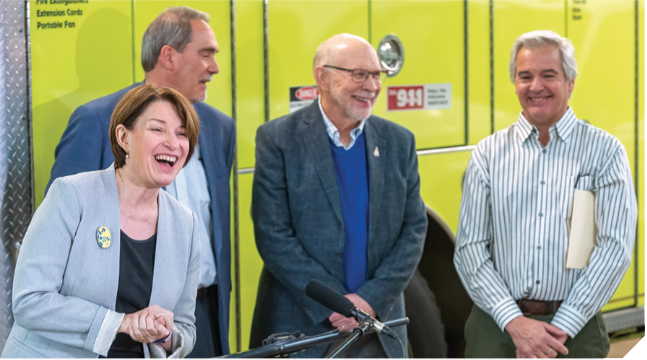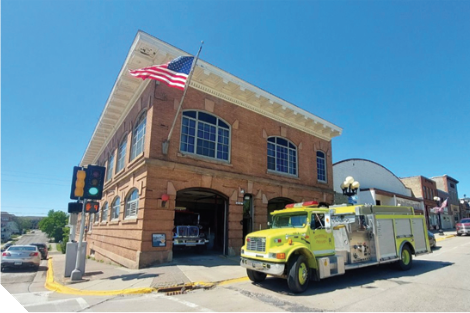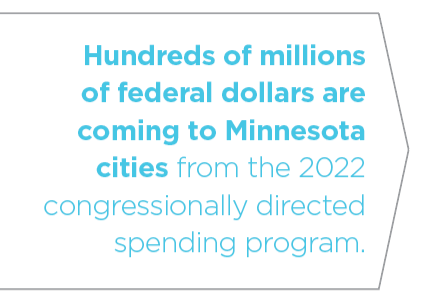Iron Range Cities Receive Federal Funds for Critical Projects
By Mary Jane Smetanka
Chisholm’s fire station is a handsome 1908 brick building, with an ornate roof line and arched windows and doors set off by decorative brick. But the building’s charm doesn’t make it functional in the 21st century.

The city has to special order fire trucks that are small enough to fit through doors designed for horse-drawn fire wagons. The fire and police departments share the cramped space, and the building’s downtown location means fire trucks have to back onto a busy road that’s also a state highway.
“It has so many limitations,” says Chisholm City Administrator Stephanie Skraba. “We’ve been looking at this issue for a good 10 years.”
Replacement is finally near, due partly to a $3.5 million federal appropriation that will allow the city to soon begin construction of a new $8.9 million station. The federal money is from the resurrected “congressionally directed spending” program, formerly referred to as “earmarks,” that was included in a huge government funding bill signed by President Biden in March 2021.
Federal funding
Earmarks, which directed federal funding to local projects, were banned in 2011 after accusations of waste and favoritism. The program was revived last year with reforms that include full disclosure on where the money goes and a requirement that only local governments and nonprofits can receive funding.
U.S. Sens. Tina Smith and Amy Klobuchar both provided an avenue for Minnesota cities to send applications to their offices for congressionally directed spending (CDS).
“I think there’s a lot more rigor in this process,” says Sen. Smith. “Sen. Klobuchar and I are very conscious that the projects we’re putting forward will put those dollars to good use right away.”
Hundreds of millions of federal dollars are coming to Minnesota cities from the 2022 CDS program for water and sewer projects, roads and bridges, libraries, law enforcement, technology upgrades, broadband expansion, and economic development projects. According to The New York Times, that first round of funding brought $380.3 million to the state. About 70 awards totaling over $130 million came through Smith’s office. Requests for the second round of funding are being evaluated now.
“We very much wanted to start this process up again,” Smith says. “I think this is a good idea because folks at the local level know what projects are best for them. We think the dollars are being distributed fairly.”
Chisholm’s fire department

The closer a project is to being shovel- ready, the more likely it is to win funding. That was the case in Chisholm, where for more than a decade, city officials had been trying to figure out how to replace their fire station, the only one in the city of 5,000.
Chisholm had already received state bonding money and other financial support for a new station, and it owned most of the new building site. It had been working with an architect on a 22,000-squarefoot facility that would comfortably house the fire and police departments as well as ambulance services.
Skraba says Chisholm plans to break ground on the project this fall, with the new facility opening in 2024. City officials hope the historic fire station, which sits at the heart of downtown across from City Hall, will get new life through redevelopment.
The CDS program “is a great funding source for communities our size,” Skraba says. “So much of our old infrastructure is failing. This grant was crucial for construction of this project.”
Small cities collaborate for water
Another project in the Iron Range area that received CDS funds is the new water supply and treatment plant for Aurora, Biwabik, Hoyt Lakes, and White Township. Those communities, with a total population of about 5,400, have each had issues with trying to maintain a supply of quality water.
Water wells used in some areas became unreliable. Very old city treatment plants needed expensive maintenance. Some of the former mine pits that communities relied on for water had high sulfite and other chemical levels and very hard water, making treatment expensive.
 In one pit used for drinking water, water levels were dropping, meaning the water intake pipe eventually would be high and dry. Zebra mussels, which can cluster on and block piping, were discovered in another pit.
In one pit used for drinking water, water levels were dropping, meaning the water intake pipe eventually would be high and dry. Zebra mussels, which can cluster on and block piping, were discovered in another pit.
Aurora’s water plant was built in the 1950s. Mayor Doug Gregor says it’s in sorry shape, and the city has been talking about replacing it for almost 20 years. That’s a financial challenge for a city with about 1,700 residents. Every year, the cost of replacing the plant escalates. That’s why the $2.5 million in federal funding is huge for Aurora, where the mayor says most residents have low to medium incomes.
“We’re a small community and the cost of [a new water supply and treatment system] is estimated at $24.5 million,” Gregor says. The CDS funds “are a godsend.”
New plant set for 2024
Facing precarious water issues with an expensive solution, it was natural for the four small communities to band together to build a new centrally located treatment plant in Aurora.
“Our cities were already working together on a joint powers board on economic development,” says Biwabik Mayor Jim Weikum. “We all knew that for any one of us to build our own plant was beyond what we could afford.”
The cities identified a new water source, Embarrass Mine Lake, as a stable source of quality sustainable water for the future. But in the middle of the planning process, Biwabik had to switch its water supply as part of a mining company pit dewatering process.
Now Biwabik is receiving water through new piping linked to a barge on Embarrass Mine Lake, a project the mining company paid for. But that arrangement won’t last forever, Weikum says. “We know the day will come when we will rejoin the [new water plant] project.”
Construction of the new plant is planned for mid-2023, with completion in late 2024. At first, with a capacity to pump 1 million gallons a day, the plant will serve Aurora and White Township. That could be expanded to pump 2 million gallons daily when Biwabik and Hoyt Lakes come on board.
Several funding sources
Stefanie Dickinson, Aurora’s city clerk and treasurer, says that the project still has a funding gap. But with state bonding money in hand and a large state Water Infrastructure Grant and other non-state grants anticipated, the CDS funding means that bonding can be used for remaining expenses without burdening residents with excessively high water rates.
Relying on a deteriorating water plant has been nerve-wracking for Aurora, Dickinson says. With the federal funding, the project is much closer to reality.
“Without this funding, we’d be looking at doubling water rates,” she says. “We’re mostly residential, and we don’t have a lot of industry to offset our costs. It’s very hard for small cities to finance this.”
“The federal dollars were essential. It was make or break for this project,” Weikum adds. “It could not have gone forward without the help.”
Mary Jane Smetanka is a freelance writer.
The Application Process for Congressionally Directed Spending
While congressionally directed spending (CDS) is bringing hundreds of millions of dollars to local governments and nonprofits in Minnesota, most of the individual awards are around $1 million or less. That’s because much of the funding goes to projects that are on the verge of going forward and just need a final funding boost.
“We try to assess which projects are ready to go,” says U.S. Sen. Tina Smith.CDS funds have already been awarded for 2022, and applications have closed for 2023 funding. Eligible projects for cities include water and sewer projects, some roads and bridges, technology upgrades for law enforcement, libraries, city-owned senior and public housing, community facilities like government centers or town halls, and economic development projects. City business incubators qualify, as does something like improving roads that lead to industrial parks.
Requests for funding go through the offices of each state’s U.S. senators and representatives. The application process is different in each congressional office, but in Smith’s office, applications are not complex. Forty or 50 fields need to be filled out with details like contact information, cost, supporting organizations, and requested amounts. Only three sections need a narrative explanation.
Though applying is straightforward, deadlines the last two years have been tight, with about two weeks between opening applications and required submission dates.
Projects are vetted by federal agencies and congressional appropriations committees and are approved as part of the big federal budget bill. Whether there will be another round of CDS funding won’t be clear until the next Congress is seated in 2023. If the program continues, applications for 2024 funding would likely open next spring.

